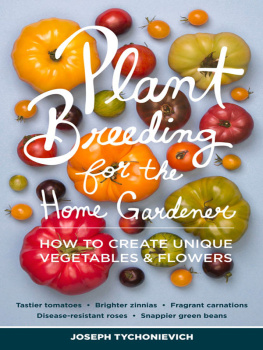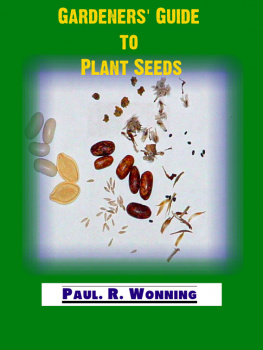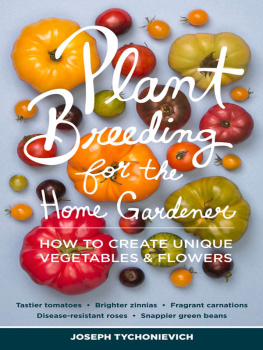
Plant Breeding for the Home Gardener

Plant Breeding for the Home Gardener
HOW TO CREATE UNIQUE VEGETABLES & FLOWERS
JOSEPH TYCHONIEVICH
TIMBER PRESS
PORTLAND LONDON
Copyright 2013 by Joseph Tychonievich. All rights reserved.
Illustrations 2013 by Marla Sidrow. All rights reserved.
Published in 2013 by Timber Press, Inc.
The Haseltine Building
133 S.W. Second Avenue, Suite 450
Portland, Oregon 97204-3527
timberpress.com
2 The Quadrant
135 Salusbury Road
London NW6 6RJ
timberpress.co.uk
ISBN-13: 978-1-60469-364-5
Printed in the United States of America Book design by Marla Sidrow
Library of Congress Cataloging-in-Publication Data Tychonievich, Joseph.
Plant breeding for the home gardener : how to create unique vegetables and flowers / Joseph Tychonievich. 1st ed.
p. cm.
Includes bibliographical references and index.
ISBN 978-1-60469-364-5
1. VegetablesBreeding. 2. Plants, OrnamentalBreeding. 3. Vegetable gardening. 4. Flower gardening. I. Title.
SB324.7.T93 2013
635dc23
2012023858
A catalog record for this book is also available from the British Library.
To my very nearly superhuman parents, for teaching me to love learning. All the good things in my life are pretty much your fault.
Contents
ACKNOWLEDGMENTS
Jackie Rosales, Kim Rupert, Andrew Barney, Adam Eckstein, and Sharon Kardos, for letting me share their perspectives on the joy of breeding plants.
Tom Fischer, for asking me to write this book and making it happen every step of the way.
The wonderful denizens of the Rose Hybridizers Association forum who, when I was a curious teenager with the breeding bug, were incredibly generous with seeds, pollen, advice, and information. It is no exaggeration to say Ive learned more about breeding from you than from all my years in universities.
Kelly Norris, for fellowship in plant obsession and marathon idea-generating phone conversations.
My numerous friends in the gardening blogosphere. Without your support and camaraderie, I would never have considered writing about plants and gardening in any way. And now here is this book. Craziness.
INTRODUCTION
As a teenager I planted in my very first garden, among other things, a few violas. Little miniature vigorous versions of pansies, which I absolutely adore. I put in a few different varietiesblack, purple and yellow, and pale yellow. They flowered heavily for me in the spring, slowed down and almost (but not quite) died in the heat of summer, then picked up again in the fall. I liked them, and I wanted to grow them again, but the next year I forgot to start the seeds. Come spring, I was kicking myself, saying I had to remember for the following year, when I went out to the garden to find it was covered with tiny viola seedlings. I had discovered the joys of self-sowing annuals. More flowers, for no work at all!
When those seedlings started flowering, I was even more delighted. In addition to the colors Id planted the year before, I had all sorts of new onesdark purple with a yellow heart, yellow with just a splash of lavender. Violas are notoriously promiscuous, and with the help of bees, the different varieties had been getting busy, filling my garden with their incredibly beautiful love children. Once many of them were flowering, I spent some very, very happy hours carefully examining them all, picking my very favorite colors and combinations of colors to keep, and weeding out the others. The next year they returned, in still more colors and forms, and again I gleefully looked them over, comparing this against that, deciding which ones I loved best. Every year, they came back, and I liked them better, as the types I didnt prefer got removed, and the ones that were pretty to my eye carried on. Not only were they more beautiful each year, I noticed that each summer they seemed to get a little better at surviving and flowering through the heat. They still preferred the cool of spring and fall, but without me doing anything at all, they were adapting to my particular climate, soil, and garden. One spring, while I was happily looking over the latest crop, the most beautiful, vigorous, and diverse yet, I suddenly realized something. These plants no longer looked or performed anything like those I had started with. They were, in fact, something new and unique, adapted to my tastes and my garden. My own personal strain of violas! How cool! Whatever should I name them?
I never did settle on a name (or if I did, Ive forgotten it), and in the constant flux that was college, living in apartments and borrowing space to garden where I could, I lost the strain. But the lesson they taught me has stuck. Plant breeding is easy. Under the right conditions, in fact, you can hardly help but breed new varieties. Just nature and a little careful weeding will all but do it for you. The other thing I learned is that breeding your own plants is not just incredibly fun and satisfying, it is also practical. Not only was my strain beautiful, it grew better for me in my conditions than the commercial varieties I had started with.
I like to call varieties like that strain of violas new heirlooms. Heirloom varieties are typically defined simply by their age, but I dont like that definition. It isnt the fact that they are old that makes heirloom tomatoes so delicious and heirloom dianthus so fragrant; rather, it is because most of these heirlooms came into being the same way my strain of violas did, from regular gardeners picking out what they liked best. While modern commercial varieties are bred with a least-common-denominator mentality, focusing on what will ship to and sell well at big box stores across the country, home gardeners focus on what they really love and get to partner with nature to create truly beautiful works of plant art.
As I became more seriously involved in gardening, many of the books I read dismissed creating new varieties as too complex to be attempted by anyone other than professionals. I knew this couldnt be true. My violas had proved that to me. More than a decade after those life-changing violas, Ive bred dozens of different genera and studied plant breeding and genetics at two universities, and Im still as convinced as ever by the lesson those little flowers taught me. Yes, it takes companies with teams of highly trained plant breeders years to create and market a new variety, but that is because the horticulture industry is complex, not because breeding is. Breeding at home is simple, easy, and effective.
Not to mention fun. Very fun. So welcome to my world. The world where every spring, Im eagerly awaiting the first opening of a flower that no one has ever seen before, where I spend summer evenings with a friend and a pile of wonderful new tomatoes, trying each one, laughing over the odd-tasting misses and cheering for the ones that move me one step closer to that dreamed-of perfect tomato in my mind. It is the same process that brought us great tomatoes like the sublime Brandywine, an ancient art form that is long overdue for a revival. If you garden, you can breed plants. In this book, Ill tell you how.

From Teosinte to sh2
A BRIEF HISTORY OF PLANT BREEDING
I ve been growing a species of grass native to Mexico in my garden this year. To the casual observer, it looks like a typical ornamental grass: a clump of many slender stems with long, narrow leaves that move gracefully in the wind. With a little coaxing, it flowered for me in late summer. As with most grasses, the flowers are tinyhardly recognizable as flowers at all. There is a little spray of male flowers, dripping pollen, at the tip of each stem, and tiny stalks of female flowers with long, silky stigmas growing at the base of some of the leaves. Later that summer the seeds matured, each stalk of female flowers producing a half-dozen small, glossy, incredibly hard, mottled gray and brown seeds.
Next page









